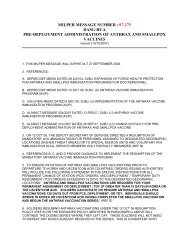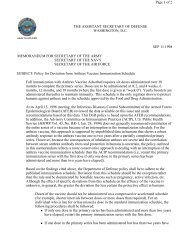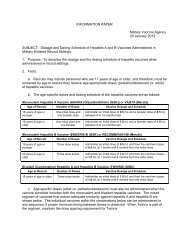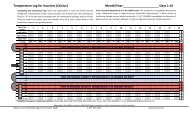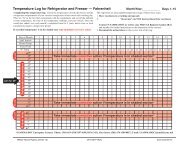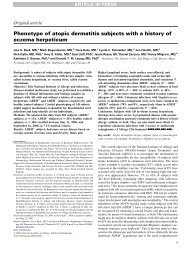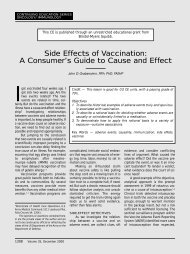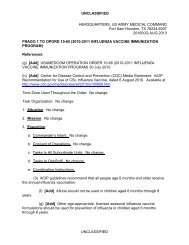Safety of anthrax vaccine: a review by the Anthrax Vaccine Expert ...
Safety of anthrax vaccine: a review by the Anthrax Vaccine Expert ...
Safety of anthrax vaccine: a review by the Anthrax Vaccine Expert ...
Create successful ePaper yourself
Turn your PDF publications into a flip-book with our unique Google optimized e-Paper software.
200 j. l. sever et al.<br />
The relative predominance <strong>of</strong> females among <strong>vaccine</strong>es<br />
reporting an AE to VAERS is consistent with<br />
findings <strong>of</strong> prior military studies that female Service<br />
personnel reported higher rates <strong>of</strong> reaction to AVA<br />
than male Service personnel. 18 Perhaps this difference<br />
has an immunological or anatomical basis, or <strong>the</strong>re<br />
might be a difference between females and males in<br />
willingness to report a given event. An apparent<br />
decline in reporting rate with successive doses <strong>of</strong><br />
AVA could also be due to several factors, such as<br />
increasing familiarity with <strong>the</strong> <strong>vaccine</strong> or possibly<br />
deferral or exemption <strong>of</strong> some <strong>vaccine</strong>es from <strong>the</strong><br />
population given subsequent doses because <strong>of</strong> reactions<br />
to previous doses. It is possible, but unproven,<br />
that temporal or geographic variations in media attention<br />
to <strong>the</strong> issue <strong>of</strong> AVA safety could have influenced<br />
<strong>the</strong> threshold for reporting an AE to VAERS. Finally,<br />
since AVA is produced from <strong>the</strong> sterile filtrate <strong>of</strong> a<br />
microaerophilic culture <strong>of</strong> attenuated B. anthracis<br />
without fixed criteria concerning <strong>the</strong> identity and<br />
quantity <strong>of</strong> bacterial antigens in each lot, <strong>the</strong>re could<br />
be a real biological basis for lot-to-lot differences in<br />
reactogenicity. Ongoing surveillance <strong>of</strong> reported<br />
AEs is needed to ascertain if a given lot is ever associated<br />
with an excessive number <strong>of</strong> medically important<br />
AEs. In <strong>the</strong> current study, lots consistently<br />
associated with an elevated reporting frequency<br />
(e.g. lot FAV041 and lot FAV044) did not differ from<br />
o<strong>the</strong>rs in regard to <strong>the</strong> clinical pr<strong>of</strong>ile <strong>of</strong> <strong>the</strong> AEs or to<br />
<strong>the</strong> rates at which SAEs or OMIAEs were reported.<br />
Lot FAV044 was cited in an FDA notice. 31 This<br />
notice, however, concerned only a labeling error that<br />
has been corrected.<br />
Future studies<br />
It is important that providers and recipients alike have<br />
access to reliable information concerning <strong>the</strong> frequencies<br />
and consequences <strong>of</strong> AEs commonly associated<br />
with vaccination. A number <strong>of</strong> studies, each involving<br />
self-reporting or direct monitoring <strong>of</strong> injection-site<br />
and systemic AEs in several hundred or thousand <strong>vaccine</strong>es<br />
given AVA have been undertaken. 9,15–18 These<br />
have served to identify a number <strong>of</strong> fairly common<br />
postvaccination complaints (e.g. inflammation at <strong>the</strong><br />
injection site, malaise, muscle or joint aches, headache,<br />
fatigue), but <strong>the</strong>re have been substantial variations<br />
between studies in <strong>the</strong> types, frequencies, and<br />
severity <strong>of</strong> reported AEs. Most <strong>of</strong> <strong>the</strong> studies have<br />
lacked at least one <strong>of</strong> <strong>the</strong> design features (i.e. randomization,<br />
blinding, use <strong>of</strong> a placebo control, uniform<br />
active surveillance <strong>of</strong> subjects given <strong>vaccine</strong> and placebo)<br />
needed to make precise, unbiased estimates <strong>of</strong><br />
<strong>the</strong> types and frequencies <strong>of</strong> AEs associated with<br />
AVA, and to decide which systemic events may be<br />
causally related to vaccination. Thus, additional<br />
well-designed, prospective studies are still needed to<br />
better define <strong>the</strong> more common AEs associated with<br />
receipt <strong>of</strong> AVA. Prospective studies with active<br />
follow-up <strong>of</strong> all <strong>vaccine</strong>es could also determine<br />
whe<strong>the</strong>r <strong>the</strong> frequency or severity <strong>of</strong> AEs following<br />
receipt <strong>of</strong> AVA is similar to that associated with o<strong>the</strong>r<br />
commonly used <strong>vaccine</strong>s such as tetanus toxoid or<br />
influenza and whe<strong>the</strong>r frequency or severity increases<br />
with successive doses <strong>of</strong> AVA.<br />
These needs will be addressed at least in part<br />
through a new CDC/DoD study based on results from<br />
a preliminary study <strong>of</strong> 173 adults suggesting that<br />
intramuscular as opposed to subcutaneous injection<br />
<strong>of</strong> AVA is associated with lower rates <strong>of</strong> local<br />
injection-site reactions and that a reduced number <strong>of</strong><br />
doses given <strong>by</strong> ei<strong>the</strong>r route may induce a similar level<br />
<strong>of</strong> antibody as <strong>the</strong> current regimen. 32 The CDC and<br />
DoD plan to fur<strong>the</strong>r assess <strong>the</strong>se findings in a randomized,<br />
controlled study involving approximately 1600<br />
adult male and female <strong>vaccine</strong>es. Slated to begin soon,<br />
initial study results should be available in 2003<br />
(N. Marano, DVM, CDC).<br />
Conclusions regarding <strong>the</strong> safety <strong>of</strong> AVA that can<br />
be drawn from VAERS reports alone will necessarily<br />
be restricted <strong>by</strong> limitations inherent in all passive surveillance<br />
systems (i.e. under-reporting as well as<br />
incomplete, inaccurate, and biased reporting <strong>of</strong><br />
events). However, as shown <strong>by</strong> its role in detecting<br />
an excess incidence <strong>of</strong> intussusception among vaccinated<br />
infants that led to <strong>the</strong> subsequent withdrawal<br />
<strong>of</strong> a live, tetravalent, rhesus-based rotavirus <strong>vaccine</strong><br />
(RRV-TV) from <strong>the</strong> market, 33–35 VAERS has <strong>the</strong> capacity<br />
to generate a warning signal if some medically<br />
important AE is occurring at a greater than expected<br />
frequency or to reveal trends in reporting (e.g. person,<br />
place, time) that might signify a safety problem (e.g.<br />
association <strong>of</strong> a particular AE with one or a few lots<br />
<strong>of</strong> <strong>vaccine</strong>).<br />
AVEC will continue to <strong>review</strong> VAERS reports concerning<br />
recipients <strong>of</strong> AVA, giving especially close<br />
attention to SAEs and OMIAEs. Should this effort<br />
detect a signal that an uncommon medically important<br />
AE may be occurring at an elevated rate, <strong>the</strong>n a large<br />
controlled study with complete ascertainment will be<br />
needed to make an informed, unbiased estimate <strong>of</strong> <strong>the</strong><br />
actual level <strong>of</strong> risk and its causal relationship to AVA.<br />
Sources <strong>of</strong> data for such a study could include <strong>the</strong><br />
Defense Medical Surveillance System (DMSS), coordinated<br />
<strong>by</strong> <strong>the</strong> Army Medical Surveillance Activity in<br />
Washington, DC, that maintains an ongoing collection<br />
Copyright # 2002 John Wiley & Sons, Ltd. Pharmacoepidemiology and Drug <strong>Safety</strong>, 2002; 11: 189–202



